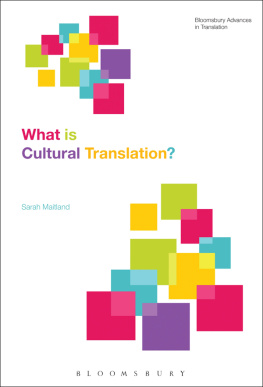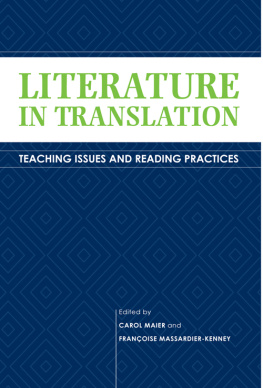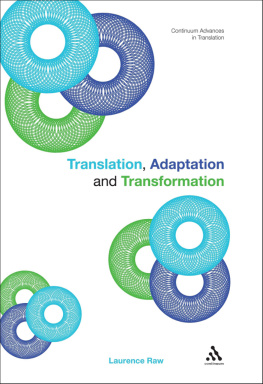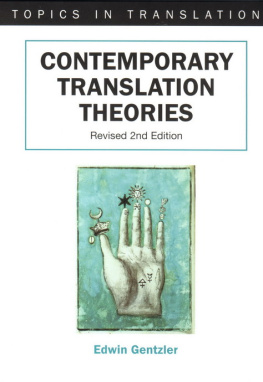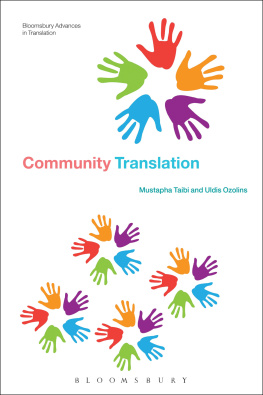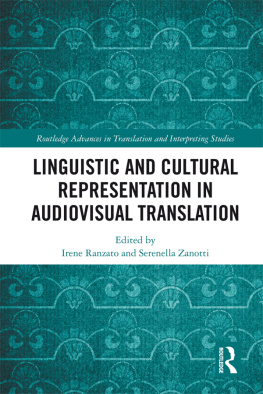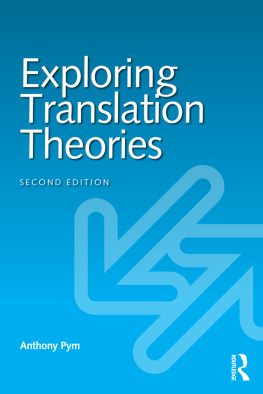What Is Cultural Translation?
Bloomsbury Advances in Translation Series
Series Editor: Jeremy Munday, Centre for Translation Studies, University of Leeds, UK
Bloomsbury Advances in Translation Studies publishes cutting-edge research in the fields of translation studies. This field has grown in importance in the modern, globalized world, with international translation between languages a daily occurrence. Research into the practices, processes and theory of translation is essential and this series aims to showcase the best in international academic and professional output.
Other titles in the series:
Community Translation
Mustapha Taibi and Uldis Ozolins
Corpus-Based Translation Studies
Edited by Alet Kruger, Kim Wallmach & Jeremy Munday
Global Trends in Translator and Interpreter Training
Edited by Sverine Hubscher-Davidson & Micha Borodo
Music, Text and Translation
Edited by Helen Julia Minors
Quality In Professional Translation
Joanna Drugan
Retranslation
Sharon Deane-Cox
The Pragmatic Translator
Massimiliano Morini
Translation, Adaptation and Transformation
Edited by Laurence Raw
Translation and Translation Studies in the Japanese Context
Edited by Nana Sato-Rossberg & Judy Wakabayashi
Translation as Cognitive Activity
Fabio Alves & Amparo Hurtado Albir
Translating For Singing
Mark Herman & Ronnie Apter
Translation, Humour and Literature
Edited by Delia Chiaro
Translation, Humour and the Media
Edited by Delia Chiaro
Translating the Poetry of the Holocaust
Jean Boase-Beier
What Is Cultural Translation?
SARAH MAITLAND
Bloomsbury Academic
An imprint of Bloomsbury Publishing Plc

Contents
My intention in this book is twofold: to develop the first in-depth definition of the evocative and yet frustratingly abstruse concept of cultural translation, and with it, to advance an argument for the relevance of translation thinking to our understanding of how we live and work in globalized societies confronted increasingly with the presence of difference in all its forms different ideologies, different modes of being and different modes of living and acting in the world. In a more specific sense, my aim is to demonstrate the critical dimension inherent in my approach to cultural translation that is, its capacity to serve as a vehicle for new ways of seeing and being that enable us to question the received ideas that structure the worlds in which we live. My argument is that it is through text in its broadest understanding through the traditions, inscriptions and institutions of culture and society that we communicate our being in the world. In a hermeneutic sense, to read the world as if it were a text is to understand something of how our being is constructed and what this implies about being alive. By looking to the practice of interlingual translation, as the purposeful means by which a text written originally in one language is made meaningful in a new time and place to an audience that speaks another, we discover complementary attitudes of explanation and understanding, interpretation and transformation analogous to the act of reading. My model thus construes translation both as the means for exploring the sociocultural phenomena of the world around us and, in turn, as a route to understanding in the world.
Over the course of five chapters I have attempted to trace cultural translation processes at work in a wide range of everyday social and cultural contexts, from the production and reception of Internet memes in
The urgency of cultural translation
To say that Europe is in a perpetual state of crisis appears to make light of the successive horrors of war, genocide, terrorism, ethnic cleansing and economic collapse. But it is simply to observe that despite the economic union of states that emerged from the Second World War, we do not, in our present configuration, enjoy a sense of political or social union. Although battles between European member states are now fought across boardroom tables, between diplomats, civil servants and heads of government, ideological division appears to be more prevalent now than ever. As I write this, the battle lines have once again been drawn and this time division in Europe is over the question of immigration. Of course, this is a question that has divided European member states for some time, not least following the outbreak of civil war in Syria and military intervention in Iraq, Afghanistan and Libya. According to the UNHCR, the majority of the 137,000 people who crossed the Mediterranean Sea into Europe during the first six months of 2015 were fleeing from war, conflict or persecution. One-third of the people who arrived safely by sea to the shores of Italy or Greece during this period were from Syria; the second and third most common countries of origin are Afghanistan and Eritrea (UNHCR, 2015). But the harrowing spectacle of mutilated bodies washed up on the shores of the Aegean and the Mediterranean, capsized dinghies, the erection of razor-wire fences, changes to border policy and refugees sewing their lips shut in protest gives the impression of nothing short of a crisis. In our debating chambers, in our newspapers, on our radios, on social media and on our television screens, some of the most urgent questions of our time are now being asked. To what extent do European member states have a responsibility towards refugees and, if so, how should this responsibility be enacted? How should the economic and social cost of responsibility be shared out more equally among the countries of Europe so that the greatest burden is not borne by only the countries of first arrival? How many refugees should each country take? By what criteria should these numbers be reached? What standards of care should states provide to refugees while their cases are being processed? The questions go on and on. But while state organs grapple with these questions and the fourth and fifth estates of the media and Internet become the battleground of debate, for the thousands of refugees who have reached Europe safely, only to find themselves stranded without access either to asylum procedures or to basic humanitarian services as a result of new border controls, the real debate is about how we imagine other people, the extent of their suffering and our duty to act upon it.
Somewhere in the acres of column inches filled by this public debate we witness the attempt to conjoin two mutually antithetical orientations that Rorty identified with regard to writing: those who write in the pursuit of self-created private perfection and autonomous human life such as Kierkegaard, Nietzsche and Heidegger and those writing in favour of the shared, social effort to make our institutions and practices more just and less cruel, as exemplified by Marx, Habermas and Rawls. Rorty believed fervently that there is no way in which philosophy or any other theoretical discipline can ever let us create a more comprehensive philosophical outlook that would somehow combine within a single vision self-creation and private perfection with justice and human solidarity. We can certainly attempt to create just and free societies where citizens are free to be as privatistic as possible, as long as they do so on their own time and cause no harm to others by depleting important resources. But at the level of theory he saw no real way to bring justice and self-creation together, for the vocabulary of self-creation is private and, by necessity, unsuited to argument, while the vocabulary of justice is necessarily public, a medium for argumentative exchange (Rorty, 1989, p. xiv).

